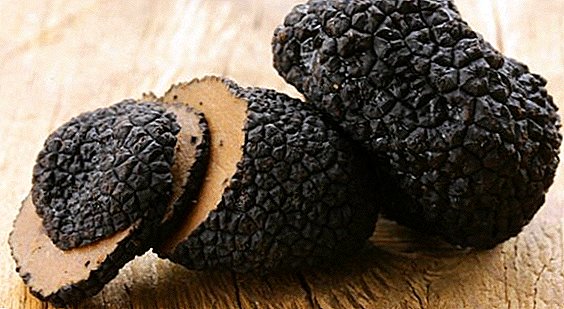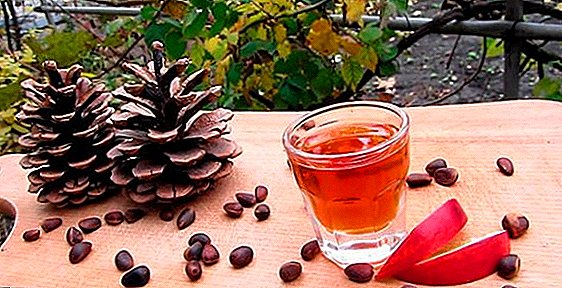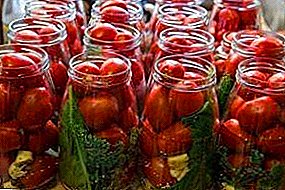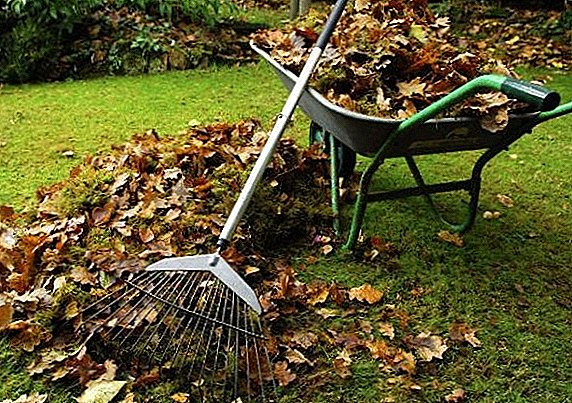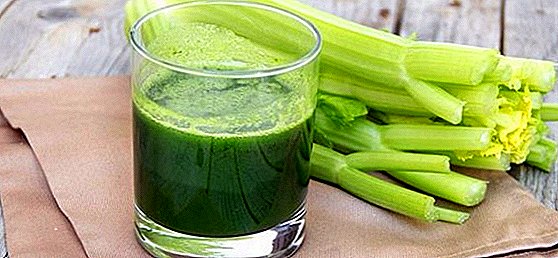 Today, no diet, with rare exceptions, is complete without celery. This green vegetable has a huge amount of nutrients that normalize the body and help in the treatment of a number of diseases. Let's see what celery is good about and how best to use it in your diet.
Today, no diet, with rare exceptions, is complete without celery. This green vegetable has a huge amount of nutrients that normalize the body and help in the treatment of a number of diseases. Let's see what celery is good about and how best to use it in your diet.
Celery Chemical Composition
The composition of the vegetable in addition to proteins, fats and carbohydrates include a huge amount of vitamins, minerals and fiber. So, it has:
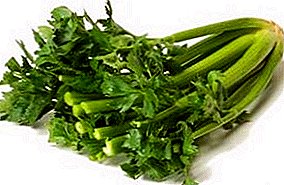 83.3% of vitamin A, which provides reproductive function, the normal development of the body, healthy skin;
83.3% of vitamin A, which provides reproductive function, the normal development of the body, healthy skin;- 90% B-carotene, which has antioxidant properties;
- 42.2% of vitamin C, which helps the body to recover, absorb iron, improves the immune system;
- 17.2% of potassium, which is involved in regulating the body's acid, water, electrolyte balance;
- 12.5% magnesium, which is involved in metabolism, synthesis of nucleic acids and protein;
- 15.4% sodium, which provides transportation of glucose, water, transmission of nerve impulses.
Did you know? The plant got into the territory of the Russian Federation during the reign of Catherine II. At first it was grown as an ornamental plant, then its medicinal properties were discovered, and only many years later it was recognized as a cultivated vegetable.
Celery Calories
100 grams of the product contains about 12-13 kcal. Its energy value is expressed in the following formula: 28% of proteins, 7% of fats, 65% of carbohydrates.
- Protein: 0.9 g. (~ 4 kcal)
- Fat: 0.1 g (~ 1 kcal)
- Carbohydrates: 2.1 g (~ 8 kcal)
Useful properties of celery
 Now let's see what celery is good for the body. Green plants are used in various bowel diseases. It copes with dysbacteriosis, inhibits fermentation processes, regulates the water-salt metabolism and lowers blood sugar levels. It is noticed that regular consumption of the green part of the plant helps to calm the nervous system, relieves from depressed mood, overwork. Freshly squeezed celery juice is used in the diet. It perfectly cleanses the body, while saturating it with valuable minerals, vitamins and other trace elements.
Now let's see what celery is good for the body. Green plants are used in various bowel diseases. It copes with dysbacteriosis, inhibits fermentation processes, regulates the water-salt metabolism and lowers blood sugar levels. It is noticed that regular consumption of the green part of the plant helps to calm the nervous system, relieves from depressed mood, overwork. Freshly squeezed celery juice is used in the diet. It perfectly cleanses the body, while saturating it with valuable minerals, vitamins and other trace elements.
Did you know? Celery is an umbrella family that lives for about two years. It is considered a vegetable crop, which today has several dozen varieties. It grows in almost all countries of the world.
The properties of this plant have been studied for a long time. Celery was recommended for use by the ancient Greeks. But already in our times it was found in androgens - male sex hormones. Therefore, with regular use of vegetables in men improves the quality of sperm. Besides, The benefits of celery for men are in the prevention of prostatitis, adenoma, since the plant has an anti-inflammatory and tonic effect. Men are advised to use it raw, when it is possible to preserve its properties as much as possible, but it is also permissible as a component in dishes.
 Since celery has a lot of fiber, it is good for both sexes as an excellent tool in the fight against overweight, toxins and toxins. There is even a special diet based on celery, as it is a low-calorie product.
Since celery has a lot of fiber, it is good for both sexes as an excellent tool in the fight against overweight, toxins and toxins. There is even a special diet based on celery, as it is a low-calorie product.
Celery is useful for women with menopause and painful menstruation. In such cases, it is recommended to use water infusion of seeds. For example, women over 35 years old are recommended to drink a course of celery seed infusion four times a year so that the menopause subsequently passes unnoticed. The same drink can be used for painful menstruation - only drink infusion of seeds. The fact is that the roots and stalks of celery in this case are dangerous for women. They contain apiol, which stimulates contractions of the inner layer of the uterus, and also, in principle, has a vasodilator effect. Therefore, menstruation may increase.
Did you know? The most valuable parts of celery are its root and stems. Seeds are more often used as a seasoning in cooking, but they also have useful properties. Sometimes their oil is used in perfumery, pharmaceuticals. From the root is extracted celery salt, which is rich in organic sodium.
But in general, celery has a strengthening effect on blood vessels, and also rejuvenates the body, improving the condition of hair and nails.
Use in traditional medicine
The most valuable is still considered celery root, which It has three main therapeutic effects:
- treats the urogenital system due to the diuretic and anti-inflammatory effects;
- improves digestion;
- cleans the blood and has anti-allergic effect.
Therefore, it is recommended for diseases of the gastrointestinal tract, when the work of the stomach, liver, pancreas is impaired, appetite is reduced, meteorism is observed. To do this, it is recommended to pour 3-4 g of crushed plant root with a liter of water and infuse it for at least eight hours. The resulting tool strain and apply three times a day for a tablespoon.
 In case of inflammation of the duodenum, it is recommended to use root juice, in the same form celery is useful for the stomach in any inflammatory processes. The juice is extracted from the roots of the plant. This can be done until mid-winter, since with longer storage the useful properties are not preserved. For treatment, take two tablespoons of juice half an hour before meals three times a day. Closer to spring for this purpose, you can prepare an infusion of dried celery roots. To do this, two tablespoons of powder pour a glass of boiling water and let it brew for 10 minutes. Infusion take 50 ml of the same pattern.
In case of inflammation of the duodenum, it is recommended to use root juice, in the same form celery is useful for the stomach in any inflammatory processes. The juice is extracted from the roots of the plant. This can be done until mid-winter, since with longer storage the useful properties are not preserved. For treatment, take two tablespoons of juice half an hour before meals three times a day. Closer to spring for this purpose, you can prepare an infusion of dried celery roots. To do this, two tablespoons of powder pour a glass of boiling water and let it brew for 10 minutes. Infusion take 50 ml of the same pattern.
Its use is effective in rheumatism and gout. In this case, you can use not only the root, but also the leaves of the plant in the same proportions with water, but they need to be drawn for at least four hours. From this infusion, you can make compresses, grinding, which will not only reduce rheumatic pains, but also cure various kinds of eczema.
Due to the anti-inflammatory effect celery should be used as food for urethritis, cystitis, glomerulonephritis, pyelonephritis. It is also recommended to drink a decoction of celery seeds, prepared as follows: 2 teaspoon of seeds is poured with a glass of boiling water and boiled in a water bath for at least half an hour. Cooled and filtered decoction take 2 tbsp. lt twice a day.
 This remedy also helps to dissolve the stones in the bladder. In addition, you can drink celery teas, which are not only an excellent diuretic, but also dissolve salts in the body, treat colds and have a calming effect. To do this, two full tablespoons of chopped dried celery grass pour 0.5 liters of water and bring to a boil. On the day it is advisable to drink no more than two glasses of this tea.
This remedy also helps to dissolve the stones in the bladder. In addition, you can drink celery teas, which are not only an excellent diuretic, but also dissolve salts in the body, treat colds and have a calming effect. To do this, two full tablespoons of chopped dried celery grass pour 0.5 liters of water and bring to a boil. On the day it is advisable to drink no more than two glasses of this tea.
The ointment of the leaves and stems of the plant cures purulent wounds, ulcers, rashes, urticaria, lichen and other skin diseases. For its preparation, fresh greens with petioles must be passed through a meat grinder, and the resulting gruel mixed with an equal part of melted butter.
Celery in cooking
 The intense aroma and special taste of the plant can not fail to attract chefs. It is actively used in the manufacture of various dishes, most often as a seasoning, which has a slightly bitter taste.
The intense aroma and special taste of the plant can not fail to attract chefs. It is actively used in the manufacture of various dishes, most often as a seasoning, which has a slightly bitter taste.
Important! Celery, which is sold in our region, is the so-called odorous celery. It received the name for a spicy, pungent aroma that gives both a stem and a root vegetable. Celery, leaf and root celery are also distinguished.
All parts of the plant are used in cooking. They are added to dishes from vegetables, mushrooms, fish, meat. The root is used in the preparation of soups, salads, egg dishes, sauces. But best in taste, celery is combined with cabbage, potatoes, carrots, eggplants, tomatoes, beans.
Harvesting and storage of raw celery
For harvesting it is important to choose a healthy and fresh vegetable. It should have strong leaves, bright green color, slightly shine and intensely pleasant to smell. Leaves and roots must be firm to the touch and free from damage. The size of celery does not affect its useful properties.
Fresh vegetable is stored for three and a maximum of seven days, provided that it is contained in the refrigerator. At the same time, the root crop is recommended to be wrapped in foil or paper, and the green part should be stored in water or well moistened and wrapped in a plastic bag.
 If you need long-term storage of celery root in the winter, it is important to properly pre-assemble it. To do this, cut the leaves from the root, leaving a few petioles, root dipped in clay, dried and laid out on the shelves in the cellar. It is possible there, in the basement, to pour sand into the boxes and "plant" the harvested crop in it so that the stalks remain on top. And you can, putting celery in boxes, fill it with sand for 2-3 cm and leave it in a close place with an air temperature of 0 ... + 1 ° C.
If you need long-term storage of celery root in the winter, it is important to properly pre-assemble it. To do this, cut the leaves from the root, leaving a few petioles, root dipped in clay, dried and laid out on the shelves in the cellar. It is possible there, in the basement, to pour sand into the boxes and "plant" the harvested crop in it so that the stalks remain on top. And you can, putting celery in boxes, fill it with sand for 2-3 cm and leave it in a close place with an air temperature of 0 ... + 1 ° C.
The easiest way to store celery in dried form. Greens should be washed and hung to dry in a dark, dark place. Drying takes about a month. Then the tops should be ground into powder and stored in a sealed container or canvas bags in a dark place.
For the winter, chopped celery leaves can be frozen, although in this case the plant loses a lot of its beneficial properties. For freezing, only green branches are selected, which after washing and cutting are stored in plastic containers in the freezer.
Alternatively, chopped greens can be mixed with salt at the rate of 200-250 g of salt per kilogram of tops, folded the mixture into jars and wait until juice comes out on the surface. Then the banks can be cleaned in a cool place. Using it for cooking, note that they do not need to be added to the salt.
 Another way to store celery is pickling. To do this, kilogram of celery root is cleaned, cut into cubes and dipped in a pre-cooked boiling mixture: a liter of water mixed with 3 g of citric acid and with a tablespoon of salt. After boiling the cubes for a couple of minutes, they are taken out, cooled and put in glass jars. Prepare the marinade in advance: for 4 cups of water 3-4 buds of cloves, the same amount of black peppercorns, a glass of vinegar. Boil it, fill the jars and sterilize for 20 minutes. So get a savory snack or side dish for mushroom, meat, potato dishes.
Another way to store celery is pickling. To do this, kilogram of celery root is cleaned, cut into cubes and dipped in a pre-cooked boiling mixture: a liter of water mixed with 3 g of citric acid and with a tablespoon of salt. After boiling the cubes for a couple of minutes, they are taken out, cooled and put in glass jars. Prepare the marinade in advance: for 4 cups of water 3-4 buds of cloves, the same amount of black peppercorns, a glass of vinegar. Boil it, fill the jars and sterilize for 20 minutes. So get a savory snack or side dish for mushroom, meat, potato dishes.
You can pickle and celery leaves. To do this, the banks sterilized for 20 minutes add several bay leaves, 4 cloves of garlic, and on top, pre-washed green celery. All this is poured with hot marinade: for 4 glasses of water 100 g of sugar, 80 g of salt, a glass of vinegar. Pickled leaves are used as snacks.
Celery seed harvesting is similar to carrot and parsley seed harvesting. In the first year of the growing season, the plant breaks off a flower stalk. In the autumn the root crop is dug out and stored as carrots. In the spring selected the most healthy roots and planted in the beds. Seeds can be harvested when the umbrellas become grayish green.
Important! Do not plant celery in very fertilized soil. This will increase its growing season, and the seeds will have to be collected very late. Collect seeds only from healthy plants.
Who should not eat celery
 Talking about the charms of the plant, it is impossible not to mention the dangerous celery. Earlier it was said about its vasodilating properties and the effect on the inner layer of the uterus. therefore It is not recommended for pregnant women, as well as for those who suffer from varicose veins. Do not eat it in large quantities and nursing mothers, at least because the milk can change in taste and the child refuses to eat.
Talking about the charms of the plant, it is impossible not to mention the dangerous celery. Earlier it was said about its vasodilating properties and the effect on the inner layer of the uterus. therefore It is not recommended for pregnant women, as well as for those who suffer from varicose veins. Do not eat it in large quantities and nursing mothers, at least because the milk can change in taste and the child refuses to eat.
They should not get involved in people who have been diagnosed with gastritis or an ulcer, as well as increased acidity. Since the plant stimulates the gastrointestinal tract, it can cause discomfort.
In general, celery is an extremely useful vegetable in the diet of modern man. Find it easy. It grows everywhere, and therefore is present on the shelves of any grocery store. The plant is easy to prepare for the winter, and you can harvest any part of it. In addition, celery is well established in cooking.


 83.3% of vitamin A, which provides reproductive function, the normal development of the body, healthy skin;
83.3% of vitamin A, which provides reproductive function, the normal development of the body, healthy skin;